
 Data Structure
Data Structure Networking
Networking RDBMS
RDBMS Operating System
Operating System Java
Java MS Excel
MS Excel iOS
iOS HTML
HTML CSS
CSS Android
Android Python
Python C Programming
C Programming C++
C++ C#
C# MongoDB
MongoDB MySQL
MySQL Javascript
Javascript PHP
PHP
- Selected Reading
- UPSC IAS Exams Notes
- Developer's Best Practices
- Questions and Answers
- Effective Resume Writing
- HR Interview Questions
- Computer Glossary
- Who is Who
Internal RAM organization of Intel 8051
Internal RAM of the 8051microcontroller has two parts. First one for register banks, bit addressable memory locations, stacks etc. Another part is the SFR(Special function register) area. Only 21 addresses in the SFR area can be used in this microcontroller. Out of these 21 locations, 11are bit-addressable SFR locations.

The bit addressable SFRs are like below -
| Register |
Byte address |
Bit-address |
|---|---|---|
| P0 (Port 0) |
80H |
80H to 87H |
| P1 (Port 1) |
90H |
90H to 97H |
| P2 (Port 2) |
A0H |
A0H to A7H |
| P3 (Port 3) |
B0H |
B0H to B7H |
| PSW |
D0H |
D0H to D7H |
| Register A (Accumulator) |
E0H |
E0H to E7H |
| Register B |
F0H |
F0H to F7H |
| TCON (Timer Control) |
88H |
88H to 8FH |
| SCON (Serial Control) |
98H |
98H to 9FH |
| IE (Interrupt Enable) |
A8H |
A8H to AFH |
| IP (Interrupt Priority) |
B8H |
B8H to BFH |
Now let us see the PSW register in detail.
The PSW (Program StatusWord) is basically the conventional flag registers. It isBit-Addressable SFR. The Byte address of PSW is D0H. Though the bit range D0H to D7H are considered as PSW, only 7 bits are valid.

| Flag Bit |
Bit Address |
Description |
|---|---|---|
| Cy |
D7H |
Carry Flag. It is affected by executing instructions like Add, Sub, rotate through carrying etc. It also be used as the 1-bit accumulator |
| Ac |
D6H |
Auxiliary Carry Flag. This is used for BCD operations. This flag is not directly used by the user. |
| F0 |
D5H |
It is user defined flag bit. This flag is general purpose. |
| RS1 and RS1 |
D4H and D3H |
These two bits are used for register select. The four register banks can be selected by these two flags. |
| Ov |
D2H |
This is the overflow flag. When after addition or subtraction the result is outside the signed 8-bit range (-128 to 127), this flag is enabled |
| X |
D1H |
This is reserved for future use. |
| P |
D0H |
This is the parity flag. After executing an instruction, it checks the number of 1s in the accumulator and based on that it is enabled or disabled. |
The 8085 had the Z-flag(Zero flag). That flag is not implemented in this 8051Microcontroller. Here it can check for zero or non-zero condition by testing the accumulator contents directly.
The RS1 and RS0 is used like this to select the register banks -
| RS1 |
RS0 |
Register Bank |
|---|---|---|
| 0 |
0 |
Register Bank 0 |
| 0 |
1 |
Register Bank 1 |
| 1 |
0 |
Register Bank 2 |
| 1 |
1 |
Register Bank 3 |
We have shown the 11 addressable bits. The remaining 10 bits are not bit-addressable.
| Register |
Byte address |
|---|---|
| SP (Stack Pointer) |
81H |
| DPL (Data Pointer Low) |
82H |
| DPH (Data Pointer High) |
83H |
| PCON (Power Control) |
87H |
| TMOD (Timer Mode) |
89H |
| TL0 (Timer0 Low) |
8AH |
| TL1 (Timer1 Low) |
8BH |
| TH0 (Timer0 High) |
8CH |
| TH1 (Timer1 Low) |
8DH |
| SBUF (Serial Buffer) |
99H |
After resetting the 8051, the SFA will follow the following rules
Stack Pointer will hold 07H
All ports (P0 to P3)will contain FFH
SBUF will hold garbage value
All other SFAs will hold 00H

